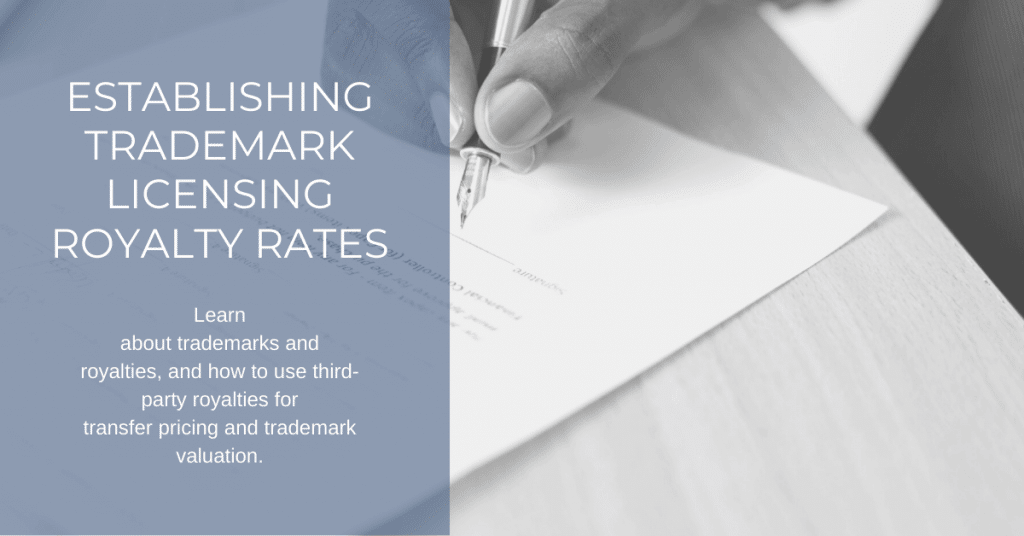Establishing trademark licensing royalty rates

Kris (Kestutis) Rudzika |
November 15, 2019

Trademark licensing royalty rates are payments made by a licensee to a licensor in exchange for the use of their trademark. For example, a fashion brand like Louis Vuitton might license their trademark ‘LV’ monogram to a sunglasses company, who will produce sunglasses bearing this distinctive mark. The sunglasses company will pay Louis Vuitton royalties for the use of the trademark – usually a percentage of gross or net sales generated by the use of the trademark.
On this page, we’ll explain:
- What trademarks are
- The purpose of a trademark licensing agreement
- What trademark royalties are
- How to set transfer prices for intercompany trademark licenses
- Where you can find market trademark royalties
Trademarks
So, what are trademarks?
The OECD defines trademarks as “words, symbols or other marks which are used by firms to distinguish their products or services from those offered by others.”
Trademarks are the unique elements that make your brand recognizable. They are legally protected under the intellectual property legislation of the relevant country.
In the cases of bigger brands, trademarks can become so well-known that they enter into everyday language. The OECD gives the example of Kleenex, which is now commonly used to refer to any type of tissue handkerchief. Google is another such trademark: the verb ‘to Google something’ is now frequently used for the act of searching on the internet, regardless of the search engine used.
Trademark license agreements
If a brand owner decides to license its trademark, it will sign a trademark license agreement with the licensee. This outlines the terms of the license, as well as the trademark licensing royalty rates.
License agreements involving trademarks will also outline the conditions of use for the trademark, with the aim of upholding its quality. After all, the trademark’s value lies in its strong reputation.
You can download examples of trademark license agreements from our database. To do so, visit our license agreements examples page, type ‘trademark’ in the search bar, and click ‘download’.
Trademark licensing royalty rates
The royalty rates set in trademark licensing deals are usually agreed as a percentage of revenue. So, the licensee will pay the licensor an agreed percentage of gross or net revenue earned by the use of the trademark. In some instances, royalties are set as fixed fees or even a lump sum.
When you are setting royalties for a trademark license deal, it can be helpful to see the rates that other companies have charged for similar trademarks. It is important to remember that trademark royalties can be affected by a number of factors, including the market and the strength of the trademark.
When you use the RoyaltyRange database, we ask you about the specifics of the trademark royalties you need. As such, you know that the data we provide meets comparability standards.
For more information about trademark licensing royalty rates, see our blog: What are royalty rates?
Transfer prices for intercompany trademark licenses
Referring to third-party trademark licensing royalty rates can help you determine fair transfer prices for intercompany transactions involving trademarks. In order to do this effectively, you must make sure the uncontrolled transactions you analyze are sufficiently comparable to your transaction.
If you are wondering what an intercompany trademark transaction looks like, here’s an example:
The licensor is an MNE that designs, manufactures and sells greetings cards under a well-known trademark (Company A). The licensee is that MNE’s parent company (Company B), which owns a number of companies within the same MNE group. The two associated entities have a trademark license agreement. Company B purchases trademarked products from Company A and sells them to third-party retailers, paying Company A agreed royalties.
In order for this intercompany transaction to meet the arm’s length standard, Company B must make sure they pay Company A the same amount as if they had been an independent entity.
If you have access to reliable comparables data, the most direct method is to refer to trademark licensing royalty rates earned in comparable license agreements between independent entities.
Find market trademark royalties today
You can use our database to find the latest royalty rates set in real trademark license deals between independent parties. This is ideal for transfer pricing analyses and trademark valuation.
Go to the bottom of this page to either:
- Request a one-off search and a full royalty rates report: We’ll search for comparable license agreements (based on your search criteria) and present the key information (including the royalty rates) in an easy-to-read report.
- Order a benchmarking study: We’ll provide an in-depth comparison of the royalty rates you’re looking to benchmark, including median and interquartile range calculations.
Request One Search
We will perform the search and deliver the initial results within hours, at no cost.




